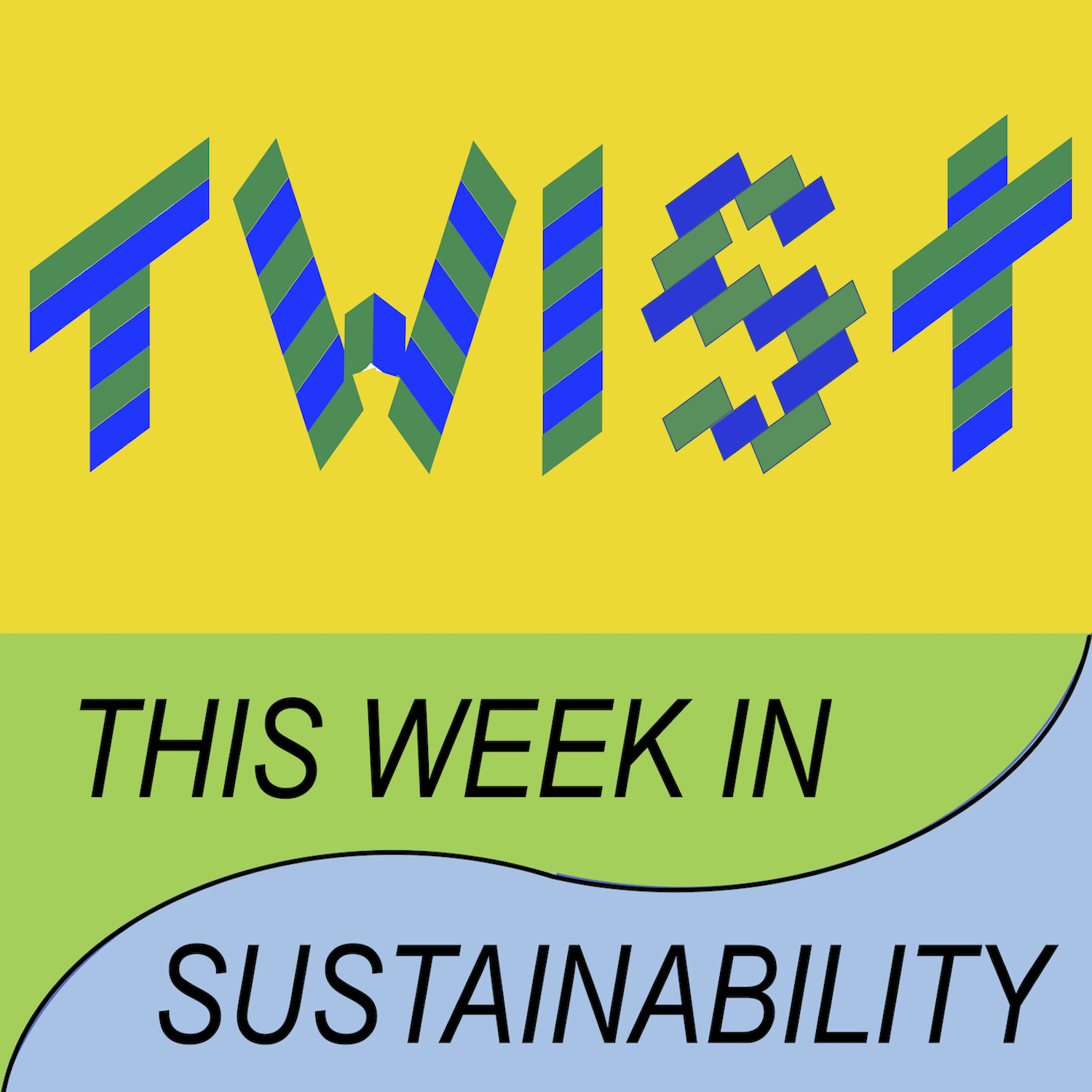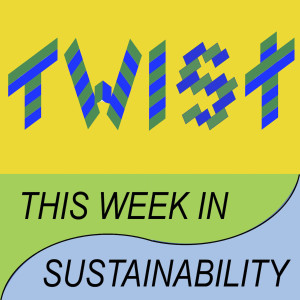
1.9K
Downloads
17
Episodes
On TWIST, This Week in Sustainability, we discuss the green pros and cons of the entire range of consumer products and everything in them, to help you choose the right stuff to buy and recycle. We’ll discuss: Appliances, Batteries, Buildings, Carpet, Cleaning Products, Clothing, Computers, Disinfectants, Food, Flame Retardants, Fuels, Medicine, Packaging, Paint, Pesticides, Plastic, Personal Care products, Phones, Photovoltaics, and maybe even tilt at Windmills. We'd love to have your suggestions for topics or guests: twist.sustainability@gmail.com! Hosted by Felicia Etzkorn, Professor of Chemistry at Virginia Tech (https://chem.vt.edu/people/faculty/teaching-and-research/fetzkorn.html) and author of Green Chemistry: Principles and Case Studies, with co-host Jamie Ferguson, Professor of Chemistry at Emory & Henry College (https://www.ehc.edu/live/profiles/341-jamie-ferguson). Music was created and performed by Wendy Godley.
Episodes

Monday Jul 26, 2021
17: Remodeling Materials
Monday Jul 26, 2021
Monday Jul 26, 2021
In which Felicia describes the materials choices for her kitchen remodel, and her guest, Helene Renard, Professor of Interior Design in the School of Architecture + Design at Virginia Tech, describes the “Healthier Materials and Sustainable Building” course she took with the Healthy Materials Lab at the Parsons School of Design. Host–Felicia Etzkorn of Virginia Tech, with music by Wendy Godley of The Kind.
Green Kitchen Remodel: https://mcdn.podbean.com/mf/web/e8tg8v/Green_Kitchen_Lecture_2015am1wy.pdf
Course: https://healthymaterialslab.org/learning-hub/e-learning-online-certificate-program
Healthy Materials Lab: https://healthymaterialslab.org/about/team
https://healthymaterialslab.org/

Monday Jun 07, 2021
16: PFAS Sass
Monday Jun 07, 2021
Monday Jun 07, 2021
In which we discuss per- and poly-fluoroalkylsubstances (PFAS) with Carol Kwiatkowski of the Green Science Policy Institute (https://greensciencepolicy.org), their properties, function, consumer products, toxicity, persistence, chemical analysis, and regulation both in the US and EU. Some companies, like Keen, are eliminating PFAS from their products. We then discuss a few green substitutes, including Solberg Co.'s firefighting foam, a fatty acid coated cellulose, and iron skillets. Host–Felicia Etzkorn of Virginia Tech, co-host–Jamie Ferguson of Emory & Henry College, with music by Wendy Godley of The Kind.
PFAS review: Kwiatkowski, C. F.; Andrews, D. Q.; Birnbaum, L. S.; Bruton, T. A.; DeWitt, J. C.; Knappe, D. R. U.; Maffini, M. V.; Miller, M. F.; Pelch, K. E.; Reade, A.; Soehl, A.; Trier, X.; Venier, M.; Wagner, C. C.; Wang, Z.; Blum, A., Scientific Basis for Managing PFAS as a Chemical Class. Env Sci & Tech Letters 2020, 7 (8), 532-543.
https://pubs.acs.org/doi/10.1021/acs.estlett.0c00255
Alternatives: https://pfascentral.org/pfas-free-products/
Keen PFAS-free: https://www.keenfootwear.com/conservation/blog-article-20390.html
Solberg Co firefighting foam: https://www.perimeter-solutions.com/class-a-b-foam/
PFAS in cosmetics: https://pubs.acs.org/doi/10.1021/acs.estlett.1c00240
PFAS in fracking: https://www.nytimes.com/2021/07/12/climate/epa-pfas-fracking-forever-chemicals.html
Dark Waters, Movie about PFAS in WV with Mark Ruffalo: https://www.yidio.com/movie/dark-waters/210401
Binding of PFOA to human serum albumin: Maso, L. et. al., Unveiling the binding mode of perfluorooctanoic acid to human serum albumin. Protein Sci 2021, 30 (4), 830-841.https://onlinelibrary.wiley.com/doi/10.1002/pro.4036
Breaking down PFAS: Lockwood, D., Photocatalyst shreds drinking water contaminant PFOA. Chem & Eng News 2018, 96 (36). https://cen.acs.org/environment/persistent-pollutants/Photocatalyst-shreds-drinking-water-contaminant/96/i36
Vermont regulations passed: https://thehill.com/changing-america/well-being/longevity/554680-vermont-governor-signs-first-in-nation-restrictions-on

Friday Apr 30, 2021
15: News Roundup: Blues, Catalytic Converters, and Fracking
Friday Apr 30, 2021
Friday Apr 30, 2021
In which we discuss the recent development of a series of new blue pigments, the theft of catalytic converters for the rhodium, and the health effects of fracking chemicals. Hosted by Felicia Etzkorn of Virginia Tech, co-host Jamie Ferguson of Emory & Henry College, and music by Wendy Godley of The Kind.
Blue pigments: https://chemistry.oregonstate.edu/content/story-yinmn-blue
Catalytic converter theft: https://www.npr.org/templates/story/story.php?storyId=129047092
Fracking chemicals: https://www.ehn.org/fractured-series-on-fracking-pollution-2650624600/fractured-fracking

Sunday Feb 28, 2021
14: Chemical Alt-Rock
Sunday Feb 28, 2021
Sunday Feb 28, 2021
In which we discuss the opportunities for substituting safer chemical alternatives for consumer products in current use with our guest, Joel Tickner of the University of Massachusetts, Lowell. We don’t need to wait for green chemistry to come up with great alternatives, many have already been designed. We need to collaborate with businesses to turn towards better alternatives, rather than imposing regulations away from the bad stuff, risking drop-in substitutions that are just as bad. Host–Felicia Etzkorn of Virginia Tech, co-host–Jamie Ferguson of Emory & Henry College, with music by Wendy Godley of The Kind.
Resources
- Joel A. Tickner, Rachel V. Simon, Molly Jacobs, Lindsey D. Pollard & Saskia K. van Bergen (2021) The nexus between alternatives assessment and green chemistry: supporting the development and adoption of safer chemicals, Green Chemistry Letters and Reviews, 14:1, 21-42, DOI: 10.1080/17518253.2020.1856427
- Tickner J, Jacobs MM, Mack NB (2019) Alternatives assessment and informed substitution: A global landscape assessment of drivers, methods, policies and needs. Sustainable Chemistry and Pharmacy 13:100161. https://www.sciencedirect.com/science/article/pii/S235255411930052X
- O'Brien M. 2000. Making Better Environmental Decisions: An Alternative to Risk Assessment, MIT Press Cambridge, MA. https://mitpress.mit.edu/books/making-better-environmental-decisions

Saturday Feb 13, 2021
13: Next Seven Generations
Saturday Feb 13, 2021
Saturday Feb 13, 2021
In which we discuss sustainable, plant-based cleaning products, oxygen-bleached paper products, recyclable and recycled packaging, transparent labeling, and consumer education with Martin Wolf, Director of Sustainability & Authenticity at Seventh Generation. Host–Felicia Etzkorn of Virginia Tech, co-host–Jamie Ferguson of Emory & Henry College, with music by Wendy Godley of The Kind.
Great resource for sustainability and environmental justice issues:

Sunday Jan 24, 2021
12: With the Weight of Lead
Sunday Jan 24, 2021
Sunday Jan 24, 2021
In which we discuss the uses of lead in gasoline (and the temporally and geographically associated violence), avgas, pipes, and car paint primer, and the greener replacements for these products—ethanol as replacement for tetraethyl lead as an anti-knock additive in gasoline, potential plastic replacements for lead pipes, and yttrium as a replacement for lead car primer.Host–Felicia Etzkorn of Virginia Tech, co-host–Jamie Ferguson of Emory & Henry College, with music by Wendy Godley of The Kind.
Abelsohn AR, Sanborn M (2010) Lead and Children, Canadian Family Physician 56:531. https://www.cfp.ca/content/56/6/531
EPA Final Revisions to the Lead and Copper Rule: https://www.epa.gov/ground-water-and-drinking-water/final-revisions-lead-and-copper-rule
Angus Chen, Zapping Lead Pipes with Electricity Could Make Them Safer for Drinking Water, Scientific American, April 4, 2019.
PPG Industries, Yttrium as a Lead Substitute in Cationic Electrodeposition Coatings, EPA Green Chemistry Challenge Award 2001. https://www.epa.gov/greenchemistry/presidential-green-chemistry-challenge-2001-designing-greener-chemicals-award
Grateful Dead, New Speedway Boogie excerpt, from What a Long Strange Trip It’s Been, 1977.

Tuesday Jan 12, 2021
11 Farming is Elemental
Tuesday Jan 12, 2021
Tuesday Jan 12, 2021
In which we interview Anthony Flaccavento, organic farmer, author, activist, and local politician, about his sustainable practices to incorporate carbon, nitrogen, and other essential elements back into the depleted soil of his former tobacco farm in southwest Virginia. No-till agriculture not only sequesters carbon and nitrogen in the soil, it balances soil water content in both drought and flood times. Host–Felicia Etzkorn of Virginia Tech, co-host–Jamie Ferguson of Emory & Henry College, with music by Wendy Godley of The Kind.
Resources
Anthony Flaccavento Building a Healthy Economy from the Bottom Up: Harnessing Real World Experience for Transformative Change (University Press of Kentucky, 2016) https://www.kentuckypress.com/9780813167596/building-a-healthy-economy-from-the-bottom-up/
SCALE — Sequestering Carbon, Accelerating Local Economies https://www.anthonyflaccavento.com/scale-inc
Savory Institute https://savory.global
National Ecological Observatory Network https://www.neonscience.org
How to Bury Carbon? Let Plants Do the Dirty Work in Nautilus
Crop innovations can protect yields and improve food quality in a changing climate
https://cen.acs.org/food/agriculture/Protecting-harvest/98/i6
Climate Change Take 5 with Tony (S.2, Ep. 4)
https://www.bottomupeconomy.org/climate-change-sustainable-farming/
Sustainable farming and social justice:
Chris Newman of Sylvanaqua https://www.sylvanaqua.com
Nina Ichikawa of the Berkeley Food Institute https://food.berkeley.edu
Joel Salatin’s Unsustainable Myth: His go-it-alone message made him a star of the food movement. Then a young Black farmer dug into what he was really saying. https://www.motherjones.com/food/2020/11/joel-salatin-chris-newman-farming-rotational-grazing-agriculture/

Saturday Dec 19, 2020
10: Fertilizer Out of Thin Air
Saturday Dec 19, 2020
Saturday Dec 19, 2020
In which we discuss the effect of synthetic nitrogen fertilizer on feeding the world, and the synthesis of ammonia from nitrogen in the air and hydrogen generated from methane, first by the Haber-Bosch process and then by electrochemical processes with our guest, Dr. Michael Stoukides from the Aristotle University of Thessaloniki, Greece. Electrodes, catalysts, yields, rates, and the potential for energy storage are discussed for the electrochemical synthesis of ammonia. Host Felicia Etzkorn of Virginia Tech, co-host Jamie Ferguson of Emory & Henry College, with music by Wendy Godley of The Kind.
Kyriakou V, Garagounis I, Vasileiou E, Vourros A, Stoukides M (2016) Progress in the Electrochemical Synthesis of Ammonia. Catalysis Today 286. https://www.researchgate.net/publication/304537323_Progress_in_the_Electrochemical_Synthesis_of_Ammonia
Kyriakou V, Garagounis I, Vourros A, Vasileiou E, Stoukides M (2019) An Electrochemical Haber-Bosch Process. Joule 4. https://www.researchgate.net/publication/337041764_An_Electrochemical_Haber-Bosch_Process

Tuesday Dec 15, 2020
9: Bury, Recycle, or Compost?
Tuesday Dec 15, 2020
Tuesday Dec 15, 2020
In which we discuss the relative merits of burying, recycling, or composting plastic waste, in particular, packaging. We distinguish biodegradable from compostable. Jamie describes Eastman Chemical Co.’s new process to take any plastic and break them down into their small molecule components and resynthesize new plastics, a true recycling process. We decide burying plastics is not so bad because it keeps carbon dioxide out of the atmosphere. Finally, we discuss the idea of geoengineering the atmosphere with sulfur dioxide to reflect sunlight back into space, which is terrible because sulfur dioxide becomes acid rain. Produced, edited and posted by Felicia Etzkorn, with co-host Jamie Ferguson. Music created and performed by Wendy Godley.
Waste by Katie O'Neill:
https://earthbound.report/2019/08/19/book-review-waste-by-kate-oneill/
Eastman Unveils Recycling Solution to Combat Global Plastic Waste: https://www.waste360.com/plastics/eastman-unveils-recycling-solution-combat-global-plastic-waste

Sunday Nov 29, 2020
8: Firing Flame Retardants
Sunday Nov 29, 2020
Sunday Nov 29, 2020
In which, with our guest, Dr. Arlene Blum (www.arleneblum.com) of the Green Science Policy Institute at the University of California, Berkeley, we discuss the toxicity of flame retardants in children’s products, furniture, and her success in changing the standards for these products so that flame retardants are unnecessary to prevent the most common smoldering fires. Flame retardants are still found in TVs. Then host Felicia Etzkorn and co-host Jamie Ferguson discuss a paper about the flammability of cotton and synthetic fabrics, including the limiting oxygen index (LOI), the heat release capacity (HRC), and the peak heat release rate (PHRR), as well as a potential less toxic flame retardant, sodium hypophosphite with succinic acid.
Green Science Policy Institute: https://greensciencepolicy.org
Six Classes Videos: https://www.sixclasses.org/videos
Stapleton HM, Klosterhaus S, Keller A, Ferguson PL, van Bergen S, Cooper E, Webster TF, Blum A (2011) Identification of Flame Retardants in Polyurethane Foam Collected from Baby Products. Env. Sci. Tech.45:5323-5331. https://pubs.acs.org/doi/10.1021/es2007462
Blum A, Gold MD, Ames BN, Jones FR, Hett EA, Dougherty RC, Horning EC, Dzidic I, Carroll DI, Stillwell RN, Thenot JP (1978) Children absorb tris-BP flame retardant from sleepwear: urine contains the mutagenic metabolite, 2,3-dibromopropanol. Science 201:1020. https://science.sciencemag.org/content/sci/201/4360/1020.full.pdf
Yang CQ, He Q, Lyon RE, Hu Y, Investigation of the flammability of different textile fabrics using micro-scale combustion calorimetry, Polym. Degrad. Stab. 95 (2010) 108e115. www.sciencedirect.com/science/article/pii/S0141391009004108
Post-note: N-methylol containing flame retardants like MDPA are associated with formaldehyde release. https://ui.adsabs.harvard.edu/abs/2017SRL....2450114Y/abstract
